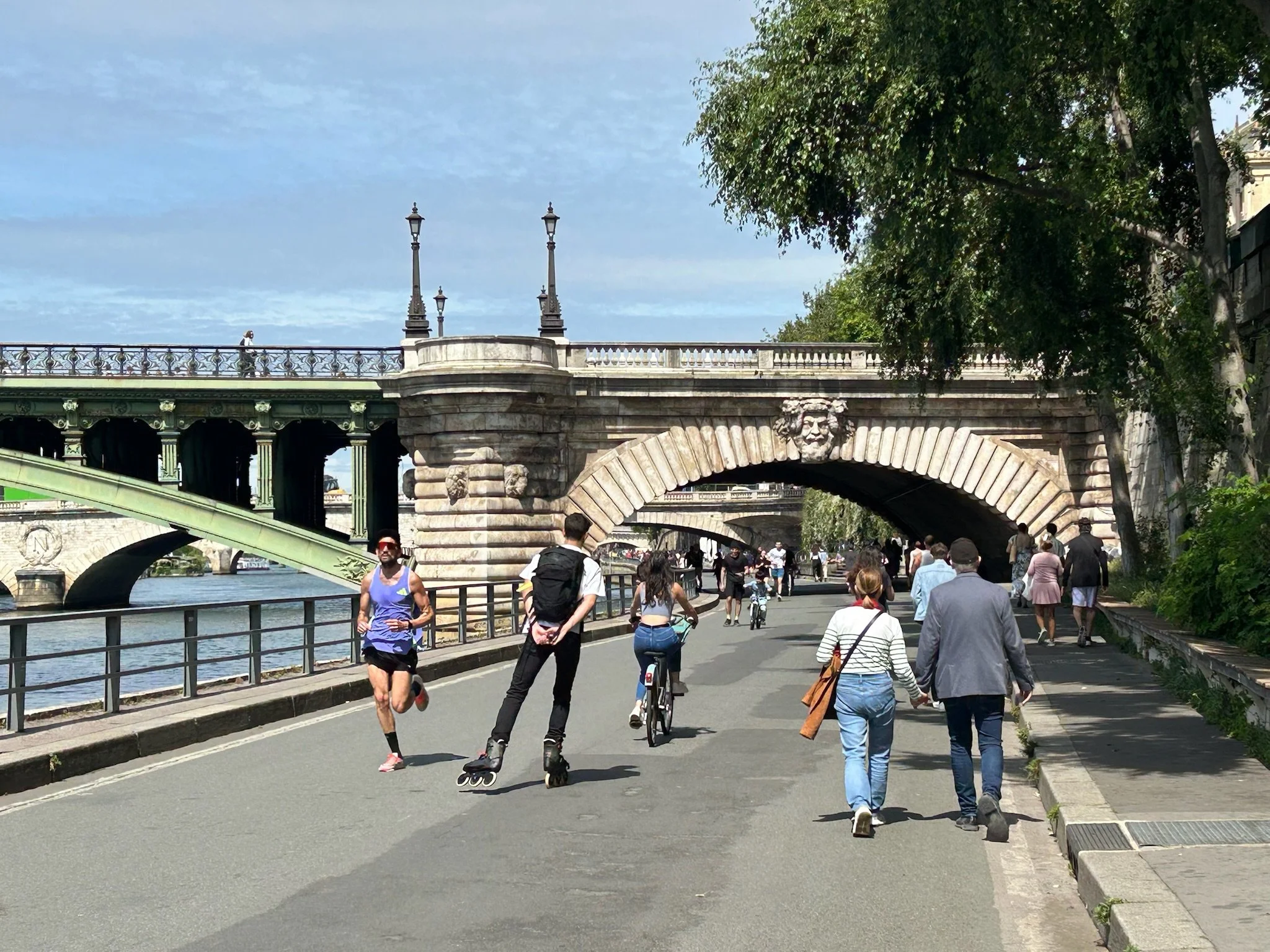Can paths put Atlanta in the same league as Paris?
By Kevin H. Posey
Note: this column was originally published in the November 2025 issue of the Lake Claire Clarion.
Major events can be the catalyst for major change, as Atlanta showed when city leaders used the 1996 Olympics to create Centennial Park. Paris went even bigger when they leveraged the 2024 Olympics to vastly expand their micromobility infrastructure into a citywide network. Bike lanes and paths are relatively cheap and simple to build, compared to highways and fixed rail transit. This means that Paris could build a lot very quickly without overly burdening hard-pressed budgets. Atlanta can do the same, or better, via the newly approved Trails ATL plan, especially if we can get well underway in time for our part of the FIFA World Cup.
Micromobility isn’t just people on e-bikes and standing scooters. Powered wheelchairs or personal mobility scooters used by those with disabilities are also part of the mix. This means that every bike lane and bike path is also a route offering freedom to those with mobility impairments. Car and transit access are no longer dealbreakers for getting around.
Paris went with a big mix of infrastructure to get its system going fast. Bi-directional bike/scooter lanes, center-running bikeways, concrete-protected lanes, parking-buffered lanes, and off-road paths are scattered throughout the city. City officials are finding that some of these options work better than others, which gives us the opportunity to learn from their trials and forgo their errors.
For example, a bi-directional bike/scooter lane offers plenty of space to pass other users, just as a two-lane road offers passing opportunities that a single-lane road does not. However, it can make access difficult to destinations on the other side of the street. A uni-directional bike path on both sides of the road offers potentially more access, but they can be too narrow for passing. The City of Paris is shifting to a solution that is the best of both worlds: uni-directional bike paths on both sides of busy streets that are wide enough to accommodate passing slower users. However, that can be tricky to pull off where the space is narrow due to sidewalks, trees, and buildings.
Center-running bikeways can be a mixed blessing. They can provide a faster route for those on e-bikes, as conflicts with pedestrians and at driveways are sharply reduced. However, access to businesses and residences along the route is made more difficult, as it’s only possible at designated crosswalks.
Concrete-protected lanes offer a level of safety for bike and scooter users that paint doesn’t. Motorists are likely to be a lot more careful, if wandering from their lane will cause damage to their vehicles. As most Paris streets now carry a low speed limit, 30 kph/18 mph, they typically use fairly subtle curbs. The higher speeds and more traffic on our streets might require a more intrusive measure, such as concrete bollards.
To avoid the need for massive numbers of big bollards on their busier streets, Paris uses parallel parking spots to offer an additional buffer to the curb-protected, bidirectional bike lane. With parking-protected bike lanes, the curb needs to be wide enough for drivers to step out on. This prevents dooring incidents or collisions between pedestrians and fast-moving e-bike riders. In some spots, Paris reconfigured spaces to create loading zones as well as parking for bikeshare and other micromobility. This keeps delivery vehicles from illegally stopping in bike and scooter lanes, while also keeping streets clear of badly-parked bikes and scooters. The catch is that all of this requires a lot of right-of-way.
Atlanta’s workaround can be to make heavy use of off-road paths. Unlike hyper-dense Paris, we have strips of property along streams, through parks, highway buffers, and abandoned rail corridors that allow us to create a connected network with minimal disruption. Care will be needed where the micromobility network crosses the road network, plus safety and lighting will need to be addressed if this is to be heavily used. But, these are solvable issues.
In order for the system to reach its full use potential, bike and scooter sharing services will need to be readily available and affordable for all Atlantans. It is also crucial that such rides be neatly parked and not blocking sidewalks, paths, nor just cast aside randomly. Paris uses strong geofencing measures to ensure that’s not a problem. Users must return rides to designated spots, which means that plenty of rides are available in these locations and not scattered haphazardly all over the city.
It’s vital that we keep the needs of businesses in mind when designing a network like that of Paris, as doing so can significantly improve the quality of life in our neighborhoods. With a full micromobility network, deliveries to residents and businesses need not be accomplished via large, polluting trucks. Cargo e-bikes are widespread in Paris, with some that come equipped with a cargo carrier on the bike AND an attached trailer.
Wouldn’t that be something to get your overnight internet order from someone on a bike like that?
Photo by the author.


